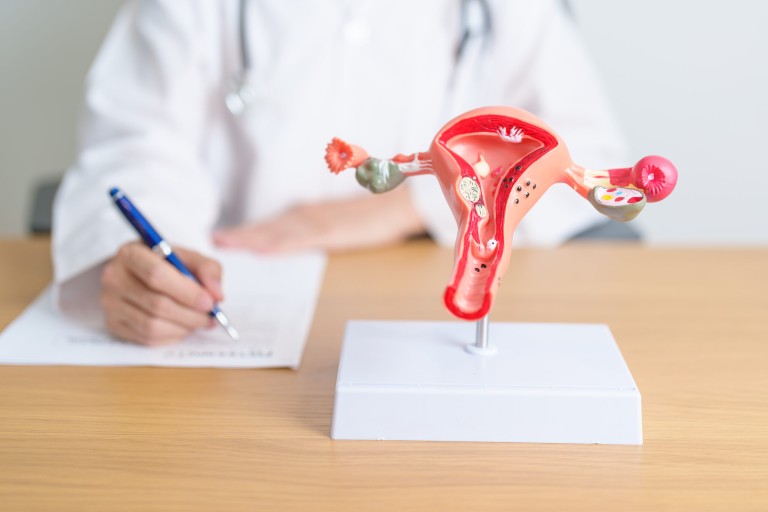Symptoms of Endometriosis:
Endometriosis is a complex condition that affects numerous women worldwide. Recognizing its symptoms early can lead to better management and improved quality of life. Here, we delve into the primary signs and how they can impact daily life.
SYMPTOMS
Symptoms of Endometriosis:
Endometriosis is a complex condition that affects numerous women worldwide. Recognizing its symptoms early can lead to better management and improved quality of life. Here, we delve into the primary signs and how they can impact daily life.
SYMPTOMS…

Experiencing THESE symptoms?
Talk to our specialists today !
Experiencing THESE symptoms?
Talk to our specialists today !
Primary Symptoms of Endometriosis:
Chronic Pelvic Pain:
Persistent pain in the pelvic region, often worsening during menstruation.
Learn more
Heavy Menstrual Bleeding:
Periods that are heavier than usual or last longer than a week.
Learn more
Painful Periods:
Intense cramping and discomfort during menstruation.
Learn more
Pain During Intercourse:
Discomfort or pain during or after sexual activity.
Learn more
Bowel and Bladder Issues:
Persistent pain in the abdomen or above the pubic area, often worsening during menstruation
Learn more
Infertility:
Difficulty getting pregnant despite regular unprotected intercourse.
Learn more

Don’t let These symptoms control your life.
Discover how we can help.

Don’t let These symptoms control your life.
Discover how we can help.
Frequently Asked Questions
- Trapped Tissue Causes Pain: Tissue similar to the one lining the inside of your uterus grows outside of it and gets trapped. When your body tries to shed this tissue during your period, it can’t exit your body, which leads to pain.
- Inflammation: The trapped tissue gets inflamed, which is your body’s way of saying it’s trying to fix a problem. This inflammation can cause swelling and pain, and over time, it can create scar tissue.
- Scar Tissue: The inflammation can lead to scar tissue, which can make organs stick together. This can cause discomfort or pain, especially when moving or during activities like sex.
- Period Pain: The tissue outside the uterus bleeds just like the lininging side during your period. But because the blood can’t go anywhere, it irritates the areas around it, causing very painful periods.
- Bleeding and Irritation: The bleeding from this tissue can irritate near by areas, which can cause pain during bowel movements or urination during your period.
- Fertility Issues: This can happening different ways, such as causing inflammation and scar tissue that can impact the function of the ovaries, fallopian tubes, and the uterus, making it more challenging for an egg to be fertilized and for a pregnancy to be carried to term.
Symptoms can vary and may change throughout the menstrual cycle. Some women experience constant symptoms, while others may have flare-ups.
Determining whether someone has endometriosis involves ruling out other conditions that might cause similar symptoms. Here’s a breakdown of the common ones:
- ● Similar Conditions: Doctors first consider other pelvic conditions like ovarian cysts or infections that can cause pain similar to endometriosis.
- ● Digestive Disorders: They also look at digestive system disorders, such as irritable bowel syndrome (IBS), which can mimic the pain and discomfort associated with endometriosis.
- ● Urinary Tract Issues: Problems with the urinary system can also produce pain that resembles the pelvic pain of endometriosis.
- ● Muscle and Bone Pain: At times, the source of pelvic pain might be the muscles and bones, rather than tissues related to the uterus.
- ● Diagnostic Imaging: Ultrasound or MRI scans can help doctors see if there’s something else inside the pelvis that’s causing the symptoms.
- ● Surgical Confirmation: The definitive way to diagnose endometriosis is through a minor surgical procedure called laparoscopy, which allows doctors to see inside the pelvis.If you’re dealing with symptoms that you think could be endometriosis, accurate diagnosis is key. Our team specializes in the surgical treatment of endometriosis and is dedicated to providing a detailed evaluation to ascertain if endometriosis is the cause of your discomfort.
Infertility is a common complication of endometriosis. While the exact numbers can vary, it is estimated that about 30% to 50% of women with endometriosis may experience infertility.
Endometriosis can be tricky to diagnose because its symptoms often resemble those of other conditions. To pinpoint the cause of your symptoms, doctors have several diagnostic tools at their disposal:
- ● Medical History and Exam: Your doctor will start with a detailed conversation about your symptoms and a physical exam.
- ● Ultrasound: This imaging test uses sound waves to create pictures of the inside of your pelvis. It can show cysts associated with endometriosis, but it can’t definitively diagnose the condition.
- ● MRI: An MRI provides a more detailed image than an ultrasound and can help doctors see the location and size of endometrial implants.
- ● Laparoscopy: This is the gold standard for diagnosing endometriosis. It’s a surgical procedure where a doctor makes a small incision and inserts a camera to look directly at the tissues inside your pelvis.
Each of these methods can provide valuable information, but a definitive diagnosis usually requires a laparoscopy. This procedure not only confirms the diagnosis but can also be used to treat the condition by removing the endometrial-like tissue.
Living with endometriosis can be challenging, but adopting a specialized nutrition and exercise plan may offer some benefits. Here’s how:
- Nutrition: Certain foods can influence your body’s hormonal balance and immune response, potentially affecting endometriosis symptoms. A diet rich in fruits, vegetables, omega-3 fatty acids, and whole grains may help reduce inflammation. On the other hand, reducing intake of red meat, caffeine, alcohol, and processed foods might lessen some symptoms.
- Exercise: Regular physical activity can help manage endometriosis in several ways. Exercise releases endorphins, which are natural painkillers produced by your body. It also helps reduce estrogen levels, which can contribute to endometrial growth, and it may decrease inflammation.
While these lifestyle changes can be beneficial, they are most effective when used as part of a comprehensive treatment plan. If you’re looking to manage your endometriosis symptoms and improve your quality of life, our expert team can guide you through a personalized treatment plan, including nutrition and exercise recommendations tailored to your needs. Contact us to learn more and to schedule a consultation. Let us support you on your journey to wellness.
Endometriosis can be managed with several non-surgical treatment options, each with its own advantages and drawbacks:
- ● Pain Medications: Over-the-counter pain relievers like ibuprofen can ease menstrual cramps and discomfort. However, they don’t treat the underlying endometriosis.
- ● Hormone Therapy: Treatments such as birth control pills, patches, and vaginal rings can reduce or eliminate menstrual flow, giving your body a break from the cycle of pain. Gonadotropin-releasing hormone (GnRH) agonists and antagonists can also halt periods and shrink endometriosis implants, but they may cause menopause-like symptoms.
- ○ Pros: Can be effective in reducing pain and slowing endometrial growth.
- ○ Cons: May have side effects like bloating, mood changes, and bonethinning with long-term use. They also don’t cure endometriosis and aren’t
suitable for women trying to conceive.
- ● Progestin Therapy: Progestin pills, injections, or intrauterine devices (IUDs) canhalt periods and the growth of endometrial tissue.
- ○ Pros: Can reduce symptoms and are an option for those who can’t takeestrogen.
- ○ Cons: May cause irregular bleeding and weight gain.While these treatments can help manage symptoms, they do not address the root cause, which is the abnormal growth of tissue outside your uterus.
Endometriosis pain is often more severe and may occur outside of menstruation. If in doubt, consult a specialist.
Leaving endometriosis untreated can lead to a progression of the condition through various stages, each potentially more severe and disruptive than the last. Initially, endometriosis may start with small areas of tissue growth outside the uterus, but over time, these can expand and deepen, leading to increased pain, inflammation, and the formation of scar tissue.
This scar tissue can cause organs to stick together, leading to significant discomfort and health complications. As endometriosis advances, it can have a profound impact on a woman’s life, including chronic pain, fertility challenges, and even affecting the function of other organs like the bladder and intestines.
While it’s true that some women experience an improvement in symptoms after reaching menopause due to the natural decline in hormone levels, this is not a guaranteed solution for everyone, and waiting for menopause can mean years of unnecessary suffering and potential complications.
Don’t wait for menopause in the hopes that endometriosis will resolve on its own. Take control of your health today. Reach out to our expert team for a consultation and explore how you can alleviate the symptoms and prevent the long-term consequences of untreated endometriosis.
Endometriosis excision surgery is a precise procedure where surgeons carefully remove the endometriosis lesions or implants from the body. Unlike other treatments that only address symptoms or reduce the growth of endometrial-like tissue, excision surgery aims to remove the problematic tissue completely.
- Why It’s Considered the Most Definitive Treatment:
Excision surgery is often regarded as the most thorough treatment for endometriosis because it seeks to eliminate the root of the pain and discomfort, not just ease the symptoms. By cutting out the endometriosis implants, the chances of these tissues growing back are significantly reduced, offering a long-term solution for many patients.
- Efficacy:
Many patients who undergo excision surgery experience a substantial reduction in pain and improvement in quality of life. For some, it can also enhance fertility. The effectiveness of the surgery depends on the extent of the endometriosis and the surgeon’s expertise.
- Safety:
As with any surgical procedure, there are risks involved. However, when performed by a specialized surgical team experienced in endometriosis excision, the procedure is considered safe. The team takes meticulous care to minimize complications and ensure the best possible outcomes.
If you’re considering surgery for endometriosis, our team of experts is here to guide you through the process. We specialize in excision surgery, offering a personalized approach to treatment that aims for the most effective results. We invite you to contact us for a detailed assessment to determine if excision surgery is the right path for you.
CONTACT US

Have more questions?
Reach out to our dedicated team for personalized advice.
- Trapped Tissue Causes Pain: Tissue similar to the one lining the inside of your uterus grows outside of it and gets trapped. When your body tries to shed this tissue during your period, it can’t exit your body, which leads to pain.
- Inflammation: The trapped tissue gets inflamed, which is your body’s way of saying it’s trying to fix a problem. This inflammation can cause swelling and pain, and over time, it can create scar tissue.
- Scar Tissue: The inflammation can lead to scar tissue, which can make organs stick together. This can cause discomfort or pain, especially when moving or during activities like sex.
- Period Pain: The tissue outside the uterus bleeds just like the lininging side during your period. But because the blood can’t go anywhere, it irritates the areas around it, causing very painful periods.
- Bleeding and Irritation: The bleeding from this tissue can irritate near by areas, which can cause pain during bowel movements or urination during your period.
- Fertility Issues: This can happening different ways, such as causing inflammation and scar tissue that can impact the function of the ovaries, fallopian tubes, and the uterus, making it more challenging for an egg to be fertilized and for a pregnancy to be carried to term.
Symptoms can vary and may change throughout the menstrual cycle. Some women experience constant symptoms, while others may have flare-ups.
Determining whether someone has endometriosis involves ruling out other conditions that might cause similar symptoms. Here’s a breakdown of the common ones:
- ● Similar Conditions: Doctors first consider other pelvic conditions like ovarian cysts or infections that can cause pain similar to endometriosis.
- ● Digestive Disorders: They also look at digestive system disorders, such as irritable bowel syndrome (IBS), which can mimic the pain and discomfort associated with endometriosis.
- ● Urinary Tract Issues: Problems with the urinary system can also produce pain that resembles the pelvic pain of endometriosis.
- ● Muscle and Bone Pain: At times, the source of pelvic pain might be the muscles and bones, rather than tissues related to the uterus.
- ● Diagnostic Imaging: Ultrasound or MRI scans can help doctors see if there’s something else inside the pelvis that’s causing the symptoms.
- ● Surgical Confirmation: The definitive way to diagnose endometriosis is through a minor surgical procedure called laparoscopy, which allows doctors to see inside the pelvis.If you’re dealing with symptoms that you think could be endometriosis, accurate diagnosis is key. Our team specializes in the surgical treatment of endometriosis and is dedicated to providing a detailed evaluation to ascertain if endometriosis is the cause of your discomfort.
Infertility is a common complication of endometriosis. While the exact numbers can vary, it is estimated that about 30% to 50% of women with endometriosis may experience infertility.
Endometriosis can be tricky to diagnose because its symptoms often resemble those of other conditions. To pinpoint the cause of your symptoms, doctors have several diagnostic tools at their disposal:
- ● Medical History and Exam: Your doctor will start with a detailed conversation about your symptoms and a physical exam.
- ● Ultrasound: This imaging test uses sound waves to create pictures of the inside of your pelvis. It can show cysts associated with endometriosis, but it can’t definitively diagnose the condition.
- ● MRI: An MRI provides a more detailed image than an ultrasound and can help doctors see the location and size of endometrial implants.
- ● Laparoscopy: This is the gold standard for diagnosing endometriosis. It’s a surgical procedure where a doctor makes a small incision and inserts a camera to look directly at the tissues inside your pelvis.
Each of these methods can provide valuable information, but a definitive diagnosis usually requires a laparoscopy. This procedure not only confirms the diagnosis but can also be used to treat the condition by removing the endometrial-like tissue.
Living with endometriosis can be challenging, but adopting a specialized nutrition and exercise plan may offer some benefits. Here’s how:
- Nutrition: Certain foods can influence your body’s hormonal balance and immune response, potentially affecting endometriosis symptoms. A diet rich in fruits, vegetables, omega-3 fatty acids, and whole grains may help reduce inflammation. On the other hand, reducing intake of red meat, caffeine, alcohol, and processed foods might lessen some symptoms.
- Exercise: Regular physical activity can help manage endometriosis in several ways. Exercise releases endorphins, which are natural painkillers produced by your body. It also helps reduce estrogen levels, which can contribute to endometrial growth, and it may decrease inflammation.
While these lifestyle changes can be beneficial, they are most effective when used as part of a comprehensive treatment plan. If you’re looking to manage your endometriosis symptoms and improve your quality of life, our expert team can guide you through a personalized treatment plan, including nutrition and exercise recommendations tailored to your needs. Contact us to learn more and to schedule a consultation. Let us support you on your journey to wellness.
Endometriosis can be managed with several non-surgical treatment options, each with its own advantages and drawbacks:
- ● Pain Medications: Over-the-counter pain relievers like ibuprofen can ease menstrual cramps and discomfort. However, they don’t treat the underlying endometriosis.
- ● Hormone Therapy: Treatments such as birth control pills, patches, and vaginal rings can reduce or eliminate menstrual flow, giving your body a break from the cycle of pain. Gonadotropin-releasing hormone (GnRH) agonists and antagonists can also halt periods and shrink endometriosis implants, but they may cause menopause-like symptoms.
- ○ Pros: Can be effective in reducing pain and slowing endometrial growth.
- ○ Cons: May have side effects like bloating, mood changes, and bonethinning with long-term use. They also don’t cure endometriosis and aren’t
suitable for women trying to conceive.
- ● Progestin Therapy: Progestin pills, injections, or intrauterine devices (IUDs) canhalt periods and the growth of endometrial tissue.
- ○ Pros: Can reduce symptoms and are an option for those who can’t takeestrogen.
- ○ Cons: May cause irregular bleeding and weight gain.While these treatments can help manage symptoms, they do not address the root cause, which is the abnormal growth of tissue outside your uterus.
Endometriosis pain is often more severe and may occur outside of menstruation. If in doubt, consult a specialist.
Leaving endometriosis untreated can lead to a progression of the condition through various stages, each potentially more severe and disruptive than the last. Initially, endometriosis may start with small areas of tissue growth outside the uterus, but over time, these can expand and deepen, leading to increased pain, inflammation, and the formation of scar tissue.
This scar tissue can cause organs to stick together, leading to significant discomfort and health complications. As endometriosis advances, it can have a profound impact on a woman’s life, including chronic pain, fertility challenges, and even affecting the function of other organs like the bladder and intestines.
While it’s true that some women experience an improvement in symptoms after reaching menopause due to the natural decline in hormone levels, this is not a guaranteed solution for everyone, and waiting for menopause can mean years of unnecessary suffering and potential complications.
Don’t wait for menopause in the hopes that endometriosis will resolve on its own. Take control of your health today. Reach out to our expert team for a consultation and explore how you can alleviate the symptoms and prevent the long-term consequences of untreated endometriosis.
Endometriosis excision surgery is a precise procedure where surgeons carefully remove the endometriosis lesions or implants from the body. Unlike other treatments that only address symptoms or reduce the growth of endometrial-like tissue, excision surgery aims to remove the problematic tissue completely.
- Why It’s Considered the Most Definitive Treatment:
Excision surgery is often regarded as the most thorough treatment for endometriosis because it seeks to eliminate the root of the pain and discomfort, not just ease the symptoms. By cutting out the endometriosis implants, the chances of these tissues growing back are significantly reduced, offering a long-term solution for many patients.
- Efficacy:
Many patients who undergo excision surgery experience a substantial reduction in pain and improvement in quality of life. For some, it can also enhance fertility. The effectiveness of the surgery depends on the extent of the endometriosis and the surgeon’s expertise.
- Safety:
As with any surgical procedure, there are risks involved. However, when performed by a specialized surgical team experienced in endometriosis excision, the procedure is considered safe. The team takes meticulous care to minimize complications and ensure the best possible outcomes.
If you’re considering surgery for endometriosis, our team of experts is here to guide you through the process. We specialize in excision surgery, offering a personalized approach to treatment that aims for the most effective results. We invite you to contact us for a detailed assessment to determine if excision surgery is the right path for you.
CONTACT US


